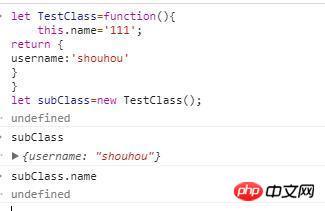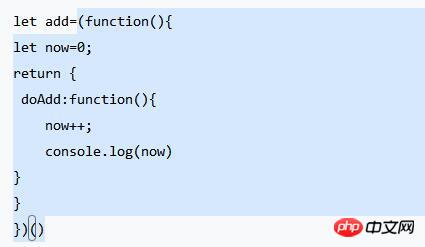
This time I will bring you the points to note in the JS interview. What are the notes to note in the JS interview? The following is a practical case, let’s take a look.
1. Foreword
During this period of time, there are many people interviewing and sharing interview questions. Some time ago, I also served as an interviewer temporarily. In order to roughly understand the level of the interviewers, I also wrote a question and interviewed several front-end developers. During this period of time, I was learning and writing about some knowledge aboutDesign Patterns. Unexpected knowledge about design patterns is what frequently makes people fall into the trap in interview questions.
So, today I will summarize the test points that make people fall into traps. Not much to say below, let’s take a look at the detailed introduction.2.Object-orientedProgramming
Regarding object-oriented and process-oriented, I personally feel that these two They are not absolutely independent, but mutually complementary. As for when to use object-oriented and when to use process-oriented, specific situations require detailed analysis.For object-oriented programming. There is a highly praised answer on Zhihu: Object-oriented: dog.eat(shit)Process-oriented: eat.(dog,shit)But this example feels like It's not very elegant. I changed it and gave a more elegant example to illustrate the difference between object-oriented and process-oriented. Requirements: Definition of 'waiting to eat hot pot'The object-oriented thinking is: waiting. Action (eating hot pot)The process-oriented thinking is: action (waiting, eating Hot pot)Code implementation:
//面向对象
//定义人(姓名)
let People=function(name){
this.name=name;
}
//动作
People.prototype={
eat:function(someThing){
console.log(`${this.name}吃${someThing}`);
}
}
//守候是个人,所以要创建一个人(new一次People)
let shouhou=new People('守候','男',24);
shouhou.eat('火锅');
//面向过程
let eat=function(who,someThing){
console.log(`${who}吃${someThing}`);
}
eat('守候','火锅');//面向对象
shouhou.coding=function(){
console.log(this.name+'写代码');
}
shouhou.coding();
//面向过程
let coding=function(who){
console.log(who+'写代码');
}
coding('守候');3.this
When developing using Let’s discuss several situations below3-1. Ordinary function call
There is no special surprise in this case, it just points to the global object - window .let username='守候'
function fn(){
alert(this.username);//undefined
}
fn();var username='守候'
function fn(){
alert(this.username);//守候
}
fn();
//---------------
window.username='守候'
function fn(){
alert(this.username);//守候
}
fn();3-2. Object function call
I believe this is not difficult to understand, it is the function call, where this points towindow.b=2222
let obj={
a:111,
fn:function(){
alert(this.a);//111
alert(this.b);//undefined
}
}
obj.fn();let obj1={
a:222
};
let obj2={
a:111,
fn:function(){
alert(this.a);
}
}
obj1.fn=obj2.fn;
obj1.fn();//2223-3.ConstructorCalling
let TestClass=function(){
this.name='111';
}
let subClass=new TestClass();
subClass.name='守候';
console.log(subClass.name);//守候
let subClass1=new TestClass();
console.log(subClass1.name)//111
3-4.apply和call调用
apply和call简单来说就是会改变传入函数的this。
let obj1={
a:222
};
let obj2={
a:111,
fn:function(){
alert(this.a);
}
}
obj2.fn.call(obj1);此时虽然是 obj2 调用方法,但是使用 了call,动态的把 this 指向到 obj1。相当于这个 obj2.fn 这个执行环境是 obj1 。apply 和 call 详细内容在下面提及。
3-5.箭头函数调用
首先不得不说,ES6 提供了箭头函数,增加了我们的开发效率,但是在箭头函数里面,没有 this ,箭头函数里面的 this 是继承外面的环境。
一个例子
let obj={
a:222,
fn:function(){
setTimeout(function(){console.log(this.a)})
}
};
obj.fn();//undefined不难发现,虽然 fn() 里面的 this 是指向 obj ,但是,传给 setTimeout 的是普通函数, this 指向是 window , window 下面没有 a ,所以这里输出 undefined 。
换成箭头函数
let obj={
a:222,
fn:function(){
setTimeout(()=>{console.log(this.a)});
}
};
obj.fn();//222这次输出 222 是因为,传给 setTimeout 的是箭头函数,然后箭头函数里面没有 this ,所以要向上层作用域查找,在这个例子上, setTimeout 的上层作用域是 fn。而 fn 里面的 this 指向 obj ,所以 setTimeout 里面的箭头函数的 this ,指向 obj 。所以输出 222 。
4.call和apply
call 和 apply 的作用,完全一样,唯一的区别就是在参数上面。
call 接收的参数不固定,第一个参数是函数体内 this 的指向,第二个参数以下是依次传入的参数。
apply接收两个参数,第一个参数也是函数体内 this 的指向。第二个参数是一个集合对象(数组或者类数组)
let fn=function(a,b,c){
console.log(a,b,c);
}
let arr=[1,2,3];
如上面这个例子
let obj1={
a:222
};
let obj2={
a:111,
fn:function(){
alert(this.a);
}
}
obj2.fn.call(obj1);call 和 apply 两个主要用途就是
1.改变 this 的指向(把 this 从 obj2 指向到 obj1 )
2.方法借用( obj1 没有 fn ,只是借用 obj2 方法)
5.闭包
闭包这个可能大家是迷糊,但是必须要征服的概念!下面用一个例子简单说下
let add=(function(){
let now=0;
return {
doAdd:function(){
now++;
console.log(now);
}
}
})()然后执行几次!

上图结果看到,now 这个变量,并没有随着函数的执行完毕而被回收,而是继续保存在内存里面。
具体原因说下:刚开始进来,因为是自动执行函数,一开始进来会自动执行,这一块

然后把这个对象赋值给 add 。由于 add 里面有函数是依赖于 now 这个变量。所以 now 不会被销毁,回收。这就是闭包的用途之一(延续变量周期)。由于 now 在外面访问不到,这就是闭包的另一个用途(创建局部变量,保护局部变量不会被访问和修改)。
可能有人会有疑问,闭包会造成内存泄漏。但是大家想下,上面的例子,如果不用闭包,就要用全局变量。把变量放在闭包里面和放在全局变量里面,影响是一致的。使用闭包又可以减少全局变量,所以上面的例子闭包更好!
相信看了本文案例你已经掌握了方法,更多精彩请关注php中文网其它相关文章!
推荐阅读:
The above is the detailed content of JS interview points to note. For more information, please follow other related articles on the PHP Chinese website!




